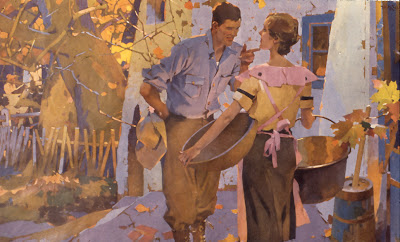Illustrator
Sam Weber has become a household fixture in the industry in just six short years. Looking at Sam's work today, you would scarcely believe he spent the first couple of years of his career with relatively little work on the table, which makes his rise to success even more impressive.
Sam earned a BFA in Calgary, Canada where he met his wife artist
Jillian Tamaki and continued on to earn an MFA at the School of Visual Arts in New Your City. He credits his time there with instilling within him a more independent attitude toward art. It also shattered some of his illusions about famous illustrators saying that living in New York rids you of being star struck pretty quickly.
A few weeks ago, I had the opportunity to meet Sam and see him work during his visit to Brigham Young University where I teach. He shared many words of wisdom with those in attendance as well as a wonderful demonstration of his working process.
Sam Begins by sketching out his ideas and then gathers reference material from a variety of sources. He stressed the importance of creating your own reference in order to control your vision. He frequently brings professional models into his Brooklyn, New York studio to shoot, ensuring that he gets exactly the pose and details he wants. Once the drawing is established, he uses a graphite transfer method to get the drawing onto his painting surface.

Weber prefers painting on Fabriano 300 lb. hot press paper. He likes the smooth surface and ability to remain relatively flat even during successive washes of wet paint without stretching. Because Weber's work frequently requires large areas of white or nearly white paper, he masks off these areas using a high tack frisket film. Sam likes to build up areas of color and value slowly using multiple washes of very thin acrylic in a watercolor style. His paint of choice is Golden Fluid acrylic paint since it requires less dilution to it reduce to the consistency he likes.
When building up value and texture, Sam employs many different tools to achieve organic results.He has a collection of natural sponges that he uses and also likes to press a sheet of Plexiglass into a wet wash to get random textures. Weber continues glazing wet into wet and building up values that retain soft edges and textures.As he gets more layers built up, the paint becomes dryer and he scumbles the paint more.
Throughout the demo, Sam threw out advice and hard gained wisdom to the group He said the sketching process is his favorite part because that is when all the potential still exists. The excitement swells and then sinks to uncertainty in the middle and then settles into relief at the finish when it all works out. Weber advocates setting aside time for personal work as the most interesting leaps and growth come from exploration.
After a little more than two hours of building up the acrylic washes, Sam then shifted to Photoshop for the finishing touches which is how he finishes nearly all his work. He scanned the image full size at 700 dpi. Using multiply layers, he continues with digital glazes of color to refine the value patterns and sharpen edges. Color dodge was used to achieve highlights toward the end. This was a fairly simple subject, so there were not a lot of tricky digital effects, but Sam will employ various selections and quick masks in order to get the effects he wants.

Of the first couple of dry years, Sam said that it was only when he shifted his subject matter to be more accessible that he became popular. He likened it to two slightly overlapping circles. In one is the work you like to do. The other contains what people want. Within the space that overlaps lies the work that you should pursue. Weber advised students to create an entirely new portfolio every six months stressing that illustration is not a part time job and that you may never feel ready to begin an illustration career- this is normal. Proceed as planned. It appears to me that Sam Weber is proceeding very nicely.



















































